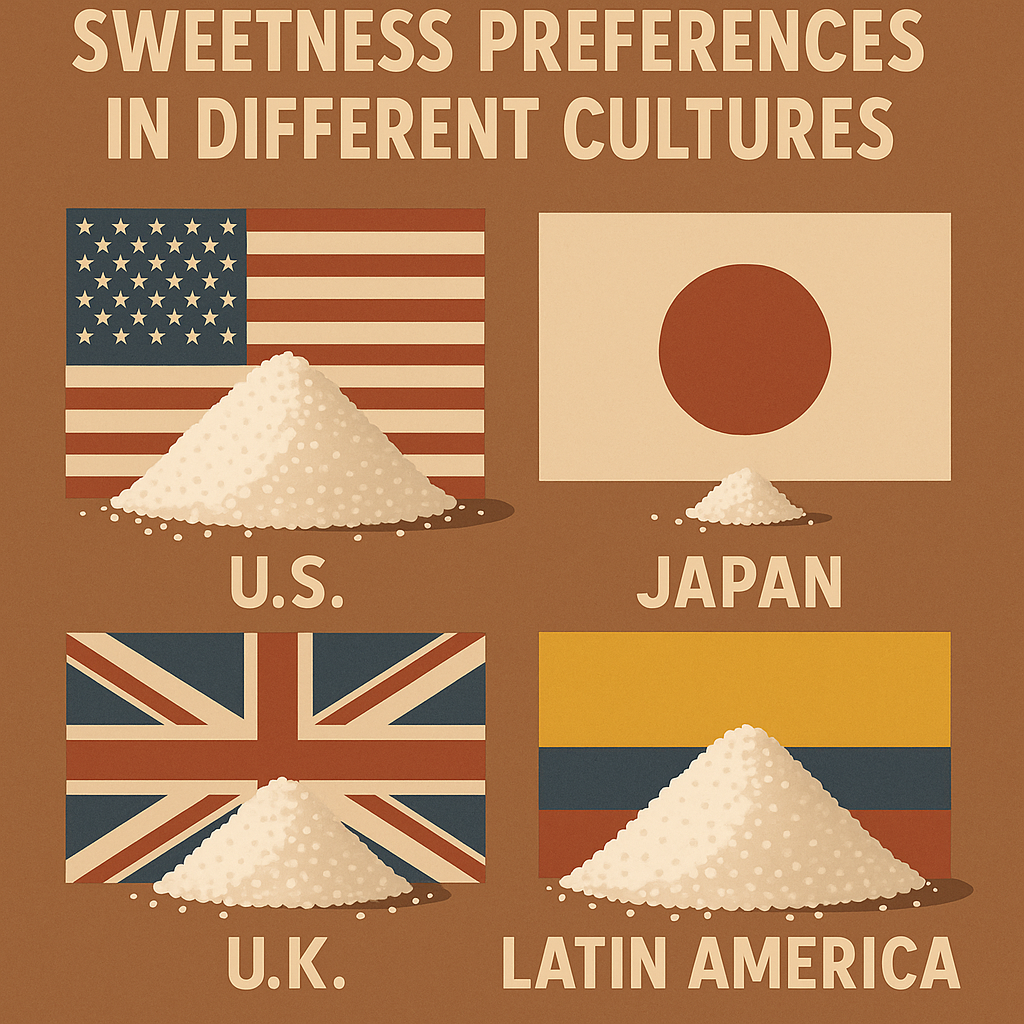 Sweetness isn’t ever just about cultural preferences—it’s deeply tied to human biology.
Sweetness isn’t ever just about cultural preferences—it’s deeply tied to human biology.
Our brains are naturally wired to respond positively to sweet tastes, which signal energy and safety. However, how much sweetness people enjoy can vary widely, influenced by where and how they grew up.
Early habits: When children are exposed to high-sugar foods from a young age, they tend to develop a stronger preference for sweet flavours that often continues into adulthood. These early taste experiences can shape long-term food choices.
Diet patterns: In countries where daily meals are predominantly savoury—like Japan and Korea—sugar can feel more intense simply because it contrasts more strongly with the rest of the diet. This makes even moderate levels of sweetness stand out more.
Cream and texture: The presence of dairy ingredients like cream and milk powder can round out and soften the perception of sweetness. That’s one reason why Swiss milk chocolate, which is rich and smooth, may taste less sweet than American versions, even if both contain similar amounts of sugar.
How People See Sweetness and Health
Across the world, sweetness also carries different meanings when it comes to health. It’s not just about taste—it’s about values, wellness trends, and even social perceptions.
 U.S. & UK: In many Western countries, especially the U.S. and UK, there's been a strong push for "low sugar" and "no added sugar" products. These claims appeal to health-conscious consumers, driven by rising awareness around obesity, diabetes, and lifestyle-related diseases.
U.S. & UK: In many Western countries, especially the U.S. and UK, there's been a strong push for "low sugar" and "no added sugar" products. These claims appeal to health-conscious consumers, driven by rising awareness around obesity, diabetes, and lifestyle-related diseases.
Japan: In Japan, the perception is quite different. Sweetness is more closely associated with refinement and balance. Overly sweet foods can come across as childish or unsophisticated, so products with subtle sweetness are often seen as more elegant—and by extension, healthier.
Latin America: In cacao-growing regions like Peru, Ecuador, and Venezuela, dark chocolate is celebrated for both its health benefits and cultural heritage. The focus is on antioxidants, origin, and craft. Sweetness here is secondary to richness, terroir, and storytelling.
Case Study: KitKat’s Global Strategy
A perfect example of how sweetness is localised is Nestlé’s KitKat. This one brand has adapted itself masterfully to different markets.
Japan: Famous for its innovation, Japan has released over 300 unique KitKat flavours. Many of them—like matcha, sake, wasabi, and roasted green tea—are lower in sugar and appeal to local preferences for mild, balanced taste. Sweetness is there, but it’s not the main act.
UK: The British version sticks to tradition with classic milk chocolate and caramel. The sweetness here is familiar, balanced by dairy richness and smooth textures that comfort more than overwhelm.
U.S.A.: In the American market, KitKat goes bold—offering indulgent flavours like birthday cake, cookies & cream, and other high-sugar innovations. Here, sweetness equals fun, comfort, and a little excess.
This case study proves a key point: even global giants can’t take a one-size-fits-all approach. Success comes from tailoring sweetness to each audience.
Tips for Chocolate Exporters
If you’re a chocolate brand looking to expand globally, understanding local sweetness preferences is just as important as mastering your supply chain or designing beautiful packaging. Here are some strategic tips:
1. Benchmark sugar levels: Don’t guess. Conduct lab analysis on local competitors to see how your product stacks up in terms of sugar content.
2. Co-create with locals: Work directly with chefs, food scientists, and taste testers in your target market. They’ll help you refine flavor, texture, and sweetness for local appeal.
3. Offer a range: Instead of betting everything on one formula, develop at least two versions—one “classic” sweeter option and one “refined” darker or lower-sugar version. This lets you reach different parts of the market without alienating anyone.
4. Tell your story: Especially in markets like Japan, consumers care deeply about the story behind your product. Talk about the origin of your cacao, your production methods, and your reasons for choosing a certain sweetness level.
Where Sweetness Is Heading
Global trends show a clear movement toward more thoughtful sweetness. Here are some of the biggest shifts shaping the future of chocolate:
Sugar reduction: Driven by increasing health awareness, consumers are more interested in products that use less sugar or rely on natural sugars.
Natural sweeteners: Alternatives like coconut blossom sugar, panela, Jagary, honey, dates, and maple syrup are gaining traction. They add flavour complexity as well as sweetness, which consumers appreciate.
Whole Pod Philosophy™: Some forward-thinking chocolate makers are starting to use the whole cacao fruit—including the pulp and juice—as a natural sweetener. This reduces waste, adds a hint of fruity acidity, and deepens the connection to origin.
The chocolate of the future may be less sweet—but more interesting, more origin-driven, and more in tune with both culture and health.
Sweetness Is Never Neutral
Sweetness isn’t just a flavour—it’s a cultural signal, a health statement, and a sensory experience. From creamy Cadbury bars in the UK to feather-light matcha truffles in Japan, chocolate teaches us that taste is anything but universal.
Whether you’re a bean-to-bar artisan or a global confectionery giant, one truth holds steady:
To sell globally, we must taste locally.
